Strange Journals
Ramblings on Bookbinding, Photography, Journaling and ArtBanded Agate Rock Box
I’ve made polymer clay boxes in the past but normally they meant to be a container for a book. Normally, I make my boxes in one of two ways. I either bake all the parts and then assemble them with a second baking or bake the box on a mold that I’ve fabricated from wood or book board. The size of the box depends on the book I’ve made how how I want it to be presented, I also tend to keep these pieces small because of the sense of intimacy they create.
While I was at PLAY last week one of the options available was making rock boxes. For the most part a rock box involves little more that wrapping a rock in polymer clay and baking it. The technique isn’t significantly different then the one I use for making my boxes except for a couple of tricks for getting the box off the rock once it’s baked. I started the box pictured below while I was at PLAY, I’d been tinkering with making a journal cover using Mokume Gane and still had a large piece of it left over. To create the effect on the surface of the box I covered a base sheet of clay with slices of the Mokume Gane and then ran it all through the pasta machine several until the distortions resembled banded agate.
The dimensions of this box are about 4 1/2″ X 3 1/4″ and it’s about 3 3/4 high. The interior of the box is simply finished with a good quality black gesso. The exterior is was wet sanded with 600, 800 and 1200 grit sand paper and then buffed on my bench grinder.
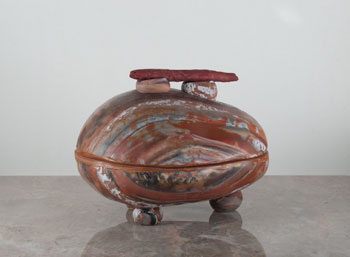
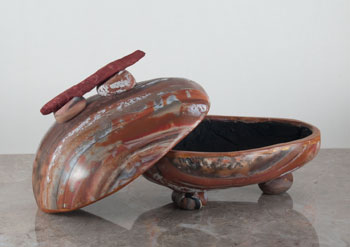
Reproducing the Lomo Look
I’ve been taking photographs for as long as I can remember and like many others they get incorporated into my journals. I’m a also a big fan of “experimental” photography and I’d say that Lomography falls into that category. For those who don’t know, Lomography is a art movement that has grown up around the Lomo camera. Originally produced in Russia and now in China, the noteworthy feature of the camera is it’s imperfections. The manufacturing process creates a lens that creates vignetting and distortions in the image and the distortions vary from camera to camera. Images from Lomo cameras tend to have a dreamlike quality that are created through a combination of the distortions built into the camera and the color saturation created by cross-processing of the film.
I’ve been thinking about buying a Lomo for years but every time I come close, I back away because of two things. The first is the hassle of finding someone to do cross processing of the film, most corporate shops won’t do it and those are the same places that are driving the mom and pop operations out of business. The second issue revolves around the potential environmental harm of the processing chemistry itself.
Still, I like the esthetic of images produced by Lomo cameras and want to produce those types of images myself. I’m still thinking about buying a Lomo but in the meantime, I’ve decided to tinker with creating similar images digitally. I’ll call them digital images in the style of Lomo since I’m sure that diehard Lomographers would have a stroke if I called them digital Lomos. Here are a couple of examples:
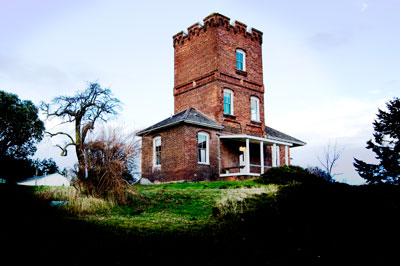
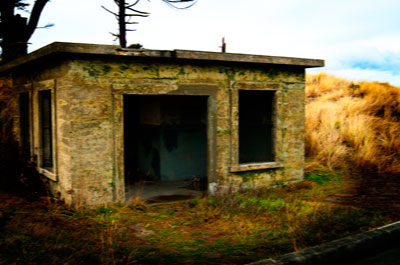
If you’d like to see some actual Lomo images and learn more about the Lomography movement, jump on over the the Lomo website.
PLAY: Day Three
Day three was a productive day as everyone worked on their projects, there were a few demos but overall people had their attention focused on finishing up their stuff.
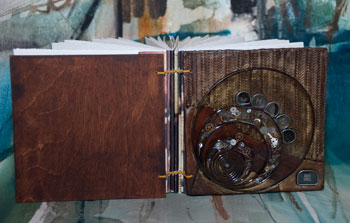
Andrew’s Steampunk Journal looked great. He created it using an old clock spring, some watch parts and Ice Resin. I thought the texture he used on the surface of the clay was very nice and was surprised to find out he used some metal corset boning to create it. Andrew is a fashion designer and apparently, he carries some around with him.
Keeley spent the time working on her creatures. Their faces were so perfect that I assumed that they were made from a mold. But as Keeley talked about the work she told me that’s not the case, each one is individually sculpted. Her material of choice is PaperClay and that that I’ve seen a good example of what you can create with it, I may have to reevaluate it as a creative tool.
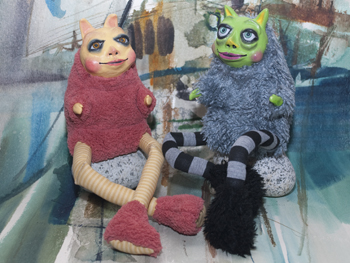
At least two polymer clay heart boxes were under construction but I know there were more.
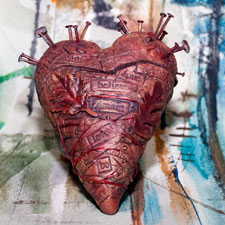
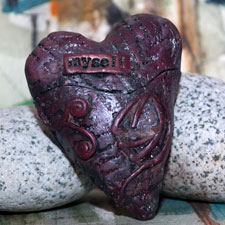
PLAY: Day Two
Most people settled into the routine of just making things today or journaling today. Several people who had started polymer clay books yesterday finished them today by completing the baking process and painting them. A few people, myself included continued working with the polymer clay and made boxes that were shaped around organic forms. Some molded forms like a heart out of foil, I used a rock.
Some of the other PLAY participants were admiring my tiny jade book and The Books of the Jade Skulls. They asked about the technique I use to create the faux jade with polymer clay so I set up a demonstration and taught them how to make it. The demonstration left me with a piece of faux jade clay, I thought about making another small pocket book with it but instead I decided to make a box. I covered a rock with a layer of gold clay, then covered the first layer with the faux jade.
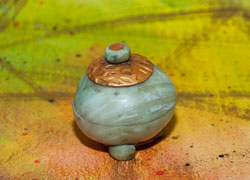
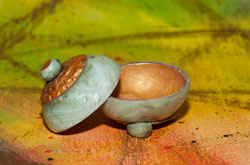
PLAY: Day One
Day one of PLAY was all about polymer clay. Tracy Moore taught his Relic Journal and demonstrated how to make journal covers using polymer clay and jewelers resin to build. This is a similar technique I used for The Book of Jade Faces, but the surfaces are painted instead of composed using colored clays. Several people were new to polymer so there were lots of questions of questions and some trial and error. There was a wide variety of styles from completely organic forms to some highly structured compositions. I’d have to give the “Eye for Detail” prize to Matt who created a forest of mushrooms on his cover complete with the gills on the underside of each mushroom.
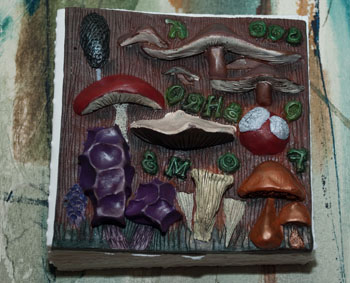
Here are a few more examples of what people were working on in various stage of completion.
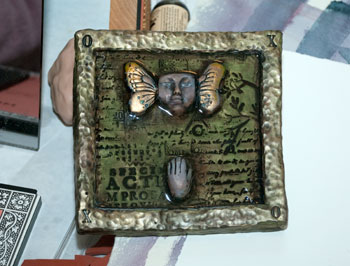
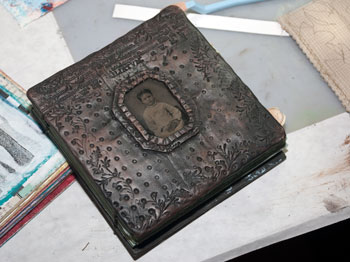
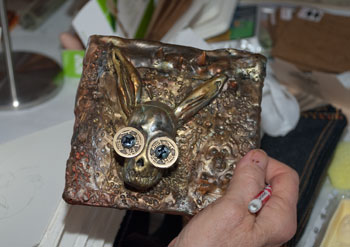
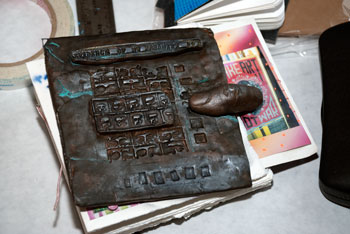
The Book of the Flying Skulls
In the process of preparing to go to PLAY for a few days I’ve bound two books, the leather wrap and The Book of Jade Faces. I’ve very satisfied with the way they both turned out but something still wasn’t right, I needed more. I wanted something… a little… beefier? I rummaging through my supplies trying to get an idea of what I wanted and then I found a piece of walnut burl, the grain and striations in the wood were fantastic. I only had one piece of walnut but I was able to squeeze two 8 1/2″ X 5 1/2″ pieces out of it. To do that however, I had to cut it so the grain was running horizontally across the cover instead of from top to bottom. Visually I think it works, the burl hides the direction of the grain well and from structural standpoint this is a fairly hard wood so there shouldn’t be any problem with wear or breakage.
The beauty of the wood called for a very simple treatment so after easing the edges and slightly rounding the corners to avoid “pokeage” a couple of coats of Tung Oil were applied, followed by a couple of coats of Carnuba Wax. The book block is 300 gm (140 Lb.) Fabriano Artistico and sewn to a leather spine with waxed polyester thread using a modified long-stitch. As the stitches go down the spine they get progressively longer and a friend commented that it creates an illusion that each series of Xs is fatter than the one above. Here are the photos:
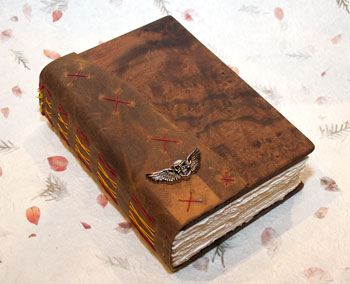
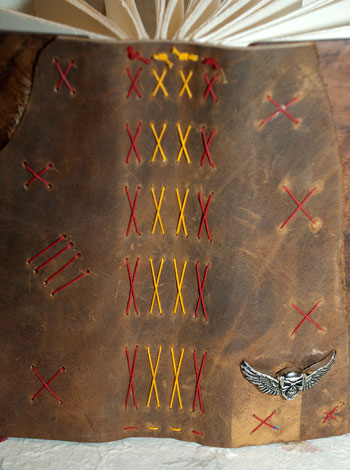
Scrap Paper
I put the last detail onto The Book of Jade Faces and as stood there looking at it there was a problem. Fabriano Artistico paper comes in 22″ X 30″ sheets and because of the size of these journals, when I tear the pages down from the sheet I’m left with a 3″ x 22″ strip of paper. Normally, I’d just toss them into my scrap bin and use them down the road but this time, the scraps lay there on the counter mocking me. What the scraps didn’t realize is the the polymer clay and all the tools were still out on the counter. They weren’t scraps for long.
This small pocket journal is 3″ X 3″. Both the front and back covers are made from polymer clay. The front cover is made from the faux jade that was used to make The Book of Jade Faces, I added some inlay just to make it a little more interesting. The inlay is gold polymer clay, the design in the inlay was created with a fairly standard mica shift technique. The back cover is the gold clay which I cut the inlay from. I’m not completely satisfied with the way it turned out and I’ll probably replace it, but it’s not bad for a few minutes work.
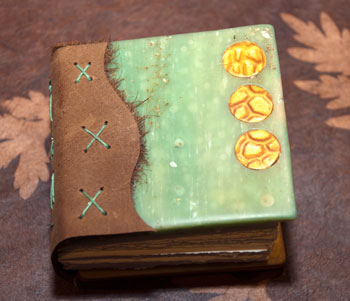
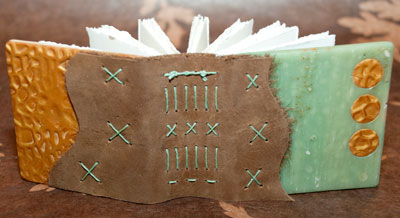
The Book of Jade Faces
Unlike Artfest which is several days of formal workshops and classes hosted by Teesha and Tracy Moore, PLAY is a “come as you are and do your own thing, but if you’re interested we’re going to teach a class or do a demo over there” affair. This year, it looks like Tracy is going to teach his Relic Journal class during PLAY. The Relic Journal is made using polymer clay, resin, leather and found objects. I’ve been working with polymer clay for years and teach a similar class but I still like Tracy’s. Tracy limits the size of journals in this class to 5 1/2″ X 5 1/2″ and when I asked him why a few years ago he said it was because of durability and weight considerations. I’ve made bigger structures out of polymer but agree with him on the weight issue, on durability i might argue if it cracks or breaks, I’m okay with that.
I know that I’ll make a Relic Journal while I’m at PLAY but I decided to make one to take with me, maybe it will be my primary journal for the next few months. I think one of the reasons I like Tracy Moore’s work is because like be he’s drawn to what I would consider dystopic forms. Most of the journals I’ve seen come out of this class in the past have at least one skull and almost all are painted in browns and blue-green hues to give the feeling of antiquity. On my leather journal I used some faux bone for the closure, when I make faux bone I generally make a large block of it and use it in several projects over the course of time. I decided to use the bone and built up the cover using a layer of the bone on top of the basic structure, I liked the way it looked but I wanted something to provide contrast with the bone. After think through a variety of options Jade seemed like a good fit. Here are some photos of the completed journal, The Book of Jade Faces.
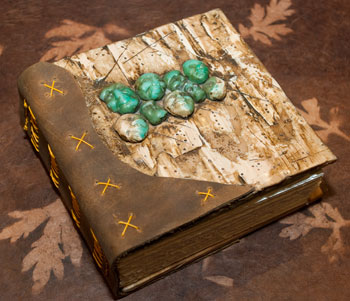
Here’s a more detailed image of the faces, when I made them using molds I laid a paper thin layer of the bone in the mold before pressing the jade into it.
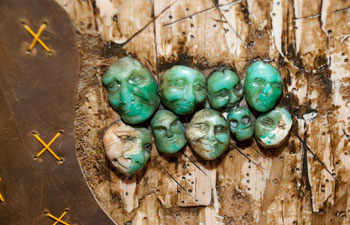
A Classic Wrap
Over the past couple of years I’ve started to use PLAY as a way point for a fresh start. I usually bind a book just before I go, take it to PLAY and then it becomes one of my primary journals for the year. I haven’t really produced anything over the past couple of months except for one book which was a birthday gift for a friend. She had mentioned what she wanted some time ago in a casual conversation and probably forgot about it. She had talked about what I typically just call a wrap, a single piece of leather that wraps around the pages to enclose them.
I made one for her with some grey leather, the dimensions were about 5″ X 8″ and although I’m not a fan of this style, I actually liked it when it was done. Later that week I stopped by the Leather Factory and found a great half-hide which was kind of a mottled milk chocolate brown… nice. The only logical thing to do? Make a journal out of it.
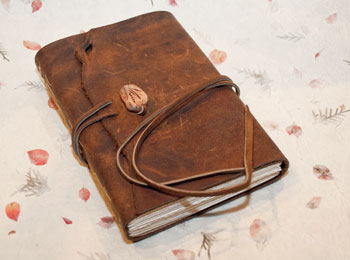
I bound this journal using the leather I found at the Leather Factory, 200 gsm (90 Lb.) Fabriano Artistic and 4-ply waxed Irish Linen thread. The closure is made from polymer clay using a faux bone technique. My original idea with this was to slip strips under the closure and then tuck them in on the back side of the journal. Here’s a detail of the closure.
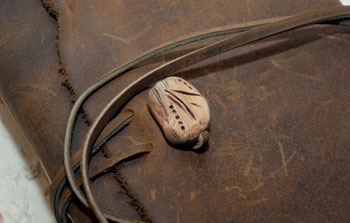
The Book of the Salmon Latte
I’ve been participating in Someguy;s 1001 Journals for a while now. I started out doing Traveling Journals which were based on the original 1000 Journals project but several of them disappeared. I decided to try location journals instead and I’ve had really good success with them, normally I leave them at coffee shops in the area and periodically I take them home and scan them. When they’re full, I do a final set of scans.
Journal 3885, The Book of the Salmon Latte was recently filled. I’ll be getting the final scans up over the next month or so and you can view them at the 1001 Journals website (http://1001journals.com).
